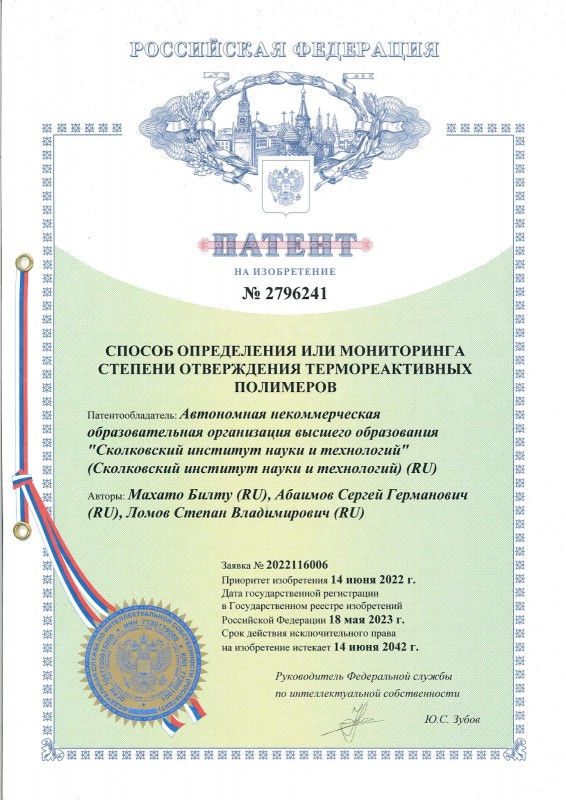Skoltech researchers supported by the Skoltech Translational Research and Innovation Program have patented a method for monitoring thermoset polymer manufacture. Parts made of thermoset polymers constitute the bulk of aircraft and marine vessels, and also go into wind turbines, cars, and high-tech sports equipment. Their manufacture involves lengthy curing in power-hungry ovens, sometimes for days. The new monitoring technique makes it possible to detect when the item is cured and terminate the process earlier, conserving time, electrical power, and freeing up the equipment for other tasks. The patent was granted by the Russian Federal Service for Intellectual Property.
Thermoset polymer products are cured, or “baked,” in huge ovens or autoclaves. Such hardware is expensive to buy and to operate. It consumes a lot of power to maintain high temperatures in the entire oven volume, sometimes for days on end. Understandably, the manufacturers seek to both minimize idle time and limit curing time to what’s strictly necessary.
The problem is that curing relies on convective air flows in the oven, which are hard to predict due to potentially complex part shapes. And the polymerization processes involved may proceed at different rates in different locations throughout the item. This leaves the manufacturer with two unpleasant options.
The company could stay on the safe side and keep the oven on longer, until there is no doubt that the chemical reaction has run its course in all parts of the item. The obvious drawbacks are higher electricity bills and wasted operating time.
The alternative is to employ any of a number of techniques to keep track of the curing degree and judge when the part is ready. However, taking actual samples is very tedious and wasteful, because the curing has to temporarily stop and then restart. This also harms the end product. Using fiber optic sensors for monitoring requires very expensive equipment. Also, the optical fibers have an adverse effect on the reinforced polymer they are embedded in, because their presence can cause stress concentrations. Acoustic and other types of sensing are expensive as well.
“We have devised a cheap, scalable, and versatile method for monitoring the degree of polymer curing,” one of the holders of the patent for the invention, Leading Research Scientist Sergey Abaimov of the Petroleum Center, commented. “It relies on embedding particles that can conduct electricity into the polymer. As curing proceeds, due to several complex processes the distances between the conducting particles and the tunneling potentials change. This has a measurable effect on the overall electrical conductivity of the item, which you can pick up using a standard multimeter — a cheap and readily available device for measuring electrical resistances. And we know how the sensor responds at different stages in the curing process, because we have established experimental references for this.”
The researchers refer to their invention as an embeddable nanosensor, but depending on the accuracy required and the funds available to the manufacturer, it can either take the form of an actual nanostructure of high complexity or merely a substance added to the polymer. The patent lists numerous classes of materials that can be used in this manner as conductive fillers for thermoset polymers. They range from metal powder to metal oxides, carbon nanotubes, graphene, and whatnot. Not necessarily nanosized or nanostructured — the team reports successful experiments, for example, with electrolytic copper powder.
The high-end version of the sensor is manufactured using a technique called chemical vapor deposition, and depending on the thermoset polymer part in question and the needs of its producers, one or many such sensors can be embedded at once.
“The icing on the cake is that, far from compromising the mechanical properties of the end product, our embeddable nanostructures and particles actually slightly improve them,” patent co-holder and Skoltech PhD student Biltu Mahato said. “Our method could be especially helpful when it comes to really large parts whose manufacture requires the prolonged operation of huge ovens or autoclaves. This is particularly true for sea vessels, and even more so, for aircraft, where the proportion of thermoset polymer parts is huge, ranging from 30% to more than 50% for an Airbus A350, the Russian Irkut MS 21, and Boeing 787. Making their manufacture more efficient will make a huge impact.”
Contact information:
Skoltech Communications
+7 (495) 280 14 81

